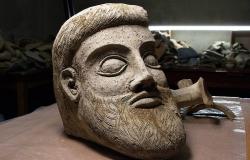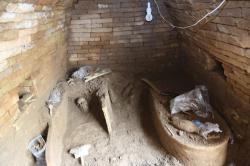INSTITUT SUPERIEUR D'ANTHROPOLOGIE
INSTITUTE OF ANTHROPOLOGY
ONLINE COURSES / COURS A DISTANCE
SPRING TERM : APRIL 2017
REGISTER NOW
RUSSIE –  Ak-Burun Cape - The head of Russia’s Academy of Sciences under water unit, Sergei Olkhovsky, announced on Wednesday that part of an ancient Greek terra-cotta statue was discovered at the Crimean bridge construction site, TASS, the Russian News Agency has reported. The discovery was found during underwater diggings near the Ak-Burun Cape and is believed to be a fragment of a bigger statue. Two diving teams are working in the area where the terra-cotta statue was discovered and the divers are manually digging in order to not destroy any other pieces or artifacts that might be in the surrounding area. In ancient times, the Kerch bay served as a main shipping base on the trade route connecting the Mediterranean Sea and the Sea of Azov and since the construction of the Crimean Bridge, many artifacts from Ancient Greece have been discovered. Just last year an ancient Greek fortress over 2,000-years-old was discovered during a dig at the Kerch Peninsula and archaeologists say that it is one of the largest of its kind discovered in the Northern Black Sea Region.
Ak-Burun Cape - The head of Russia’s Academy of Sciences under water unit, Sergei Olkhovsky, announced on Wednesday that part of an ancient Greek terra-cotta statue was discovered at the Crimean bridge construction site, TASS, the Russian News Agency has reported. The discovery was found during underwater diggings near the Ak-Burun Cape and is believed to be a fragment of a bigger statue. Two diving teams are working in the area where the terra-cotta statue was discovered and the divers are manually digging in order to not destroy any other pieces or artifacts that might be in the surrounding area. In ancient times, the Kerch bay served as a main shipping base on the trade route connecting the Mediterranean Sea and the Sea of Azov and since the construction of the Crimean Bridge, many artifacts from Ancient Greece have been discovered. Just last year an ancient Greek fortress over 2,000-years-old was discovered during a dig at the Kerch Peninsula and archaeologists say that it is one of the largest of its kind discovered in the Northern Black Sea Region.
http://eu.greekreporter.com/2017/03/22/crimean-bridge-construction-site-reveals-more-treasures-from-ancient-greece/
IRAQ –  Erbil - Total of 9 graves were found which are assumed to be left from the Assyrian period.
Erbil - Total of 9 graves were found which are assumed to be left from the Assyrian period.
https://www.middleeastmonitor.com/20170322-assyrian-bones-found-in-erbil/
USA –  St. Augustine - An archaeological dig in St. Augustine that deals with the burials of the first colonists of St. Augustine has taken an emotional turn. A baby's remains have been discovered. The dig is taking place in the building where A1A Aleworks is located in downtown St. Augustine on the corner of King Street and Charlotte Street. Inside the building, 12 burials have been found and more burials are being found outside on the other side of the wall. City archaeologist Carl Halbirt said the bones date back to 1572 - 1702, making them some of the first colonists in St. Augustine, buried in the oldest documented church in the country. That single bone that affected some archeological volunteers is a tiny finger or toe bone. Halbirt said it's from a newborn baby. It's less than a centimeter in length. And found next to that baby's bone was a greenish material. Halbirt said it's possibly copper meshing or possibly cloth that was next to copper. No other material has been found by any of the other bones. And this toe or finger bone may have been "preserved simply because the copper helped preserve it. We found no other evidence for that young child's or infant's remains," Halbirt noted.
St. Augustine - An archaeological dig in St. Augustine that deals with the burials of the first colonists of St. Augustine has taken an emotional turn. A baby's remains have been discovered. The dig is taking place in the building where A1A Aleworks is located in downtown St. Augustine on the corner of King Street and Charlotte Street. Inside the building, 12 burials have been found and more burials are being found outside on the other side of the wall. City archaeologist Carl Halbirt said the bones date back to 1572 - 1702, making them some of the first colonists in St. Augustine, buried in the oldest documented church in the country. That single bone that affected some archeological volunteers is a tiny finger or toe bone. Halbirt said it's from a newborn baby. It's less than a centimeter in length. And found next to that baby's bone was a greenish material. Halbirt said it's possibly copper meshing or possibly cloth that was next to copper. No other material has been found by any of the other bones. And this toe or finger bone may have been "preserved simply because the copper helped preserve it. We found no other evidence for that young child's or infant's remains," Halbirt noted.
http://www.firstcoastnews.com/news/a-babys-bone-discovered-in-archaeological-dig-in-st-augustine/424343737
TCHAD –  Ennedi Caves - Ancient cave paintings at a world heritage site in the Sahara desert have been defaced with graffiti, Chad's minister of culture has told the BBC. The graffiti drawn on the paintings, which are about 8,000 years old, was "a tragedy... offensive to the whole history and memory of Chad," Mahamat Saleh Haroun said. Vandals scrawled their names on top of the artworks in French and Arabic. The Ennedi plateau was declared a Unesco world heritage site in 2016.
Ennedi Caves - Ancient cave paintings at a world heritage site in the Sahara desert have been defaced with graffiti, Chad's minister of culture has told the BBC. The graffiti drawn on the paintings, which are about 8,000 years old, was "a tragedy... offensive to the whole history and memory of Chad," Mahamat Saleh Haroun said. Vandals scrawled their names on top of the artworks in French and Arabic. The Ennedi plateau was declared a Unesco world heritage site in 2016.
http://www.bbc.co.uk/news/world-africa-39332438
ROYAUME UNI –  Eigg - Bones discovered in a cave on Eigg have been linked to a massacre of almost the entire island's population during a clan feud in the 16th Century. More than 50 bones were found after tourists found some of the remains in the isle's Massacre Cave last year. Analysis by archaeologists at Historic Environment Scotland has dated the remains to the time of the killings. About 400 islanders, who were members of the Macdonald clan, were murdered by a raiding party of Macleods from Skye. The islanders had been hiding in the cave for three days when they were discovered. Macleods blocked the narrow entrance to their hideout with heather and other vegetation before setting the material alight. The Macdonalds were suffocated by smoke and their bodies left in the cave. It is believed that the massacre happened in or around the year 1577.
Eigg - Bones discovered in a cave on Eigg have been linked to a massacre of almost the entire island's population during a clan feud in the 16th Century. More than 50 bones were found after tourists found some of the remains in the isle's Massacre Cave last year. Analysis by archaeologists at Historic Environment Scotland has dated the remains to the time of the killings. About 400 islanders, who were members of the Macdonald clan, were murdered by a raiding party of Macleods from Skye. The islanders had been hiding in the cave for three days when they were discovered. Macleods blocked the narrow entrance to their hideout with heather and other vegetation before setting the material alight. The Macdonalds were suffocated by smoke and their bodies left in the cave. It is believed that the massacre happened in or around the year 1577.
http://www.bbc.co.uk/news/uk-scotland-highlands-islands-39351813